HCA622: Healthcare Quality Accreditation and Evaluation Report
VerifiedAdded on 2022/11/28
|6
|1425
|286
Report
AI Summary
This report provides a detailed overview of the Commission on Accreditation of Rehabilitation Facilities (CARF), The Joint Commission (TJC), and the Accreditation Association for Ambulatory Health Care (AAAHC). It outlines their histories, missions, visions, and present-day functions within the healthcare sector. The report examines CARF's role in accrediting various customer service units, including rehabilitation services, and its focus on enhancing patient health outcomes. It also explores TJC's mission to improve healthcare quality and safety, its accreditation standards, and its future goals for evaluating organizational compliance. Furthermore, the report briefly touches upon AAAHC's history, particularly its accreditation of ambulatory health organizations. The report is designed to provide a clear understanding of the roles and significance of these accreditation bodies in ensuring quality and patient safety within the healthcare landscape.
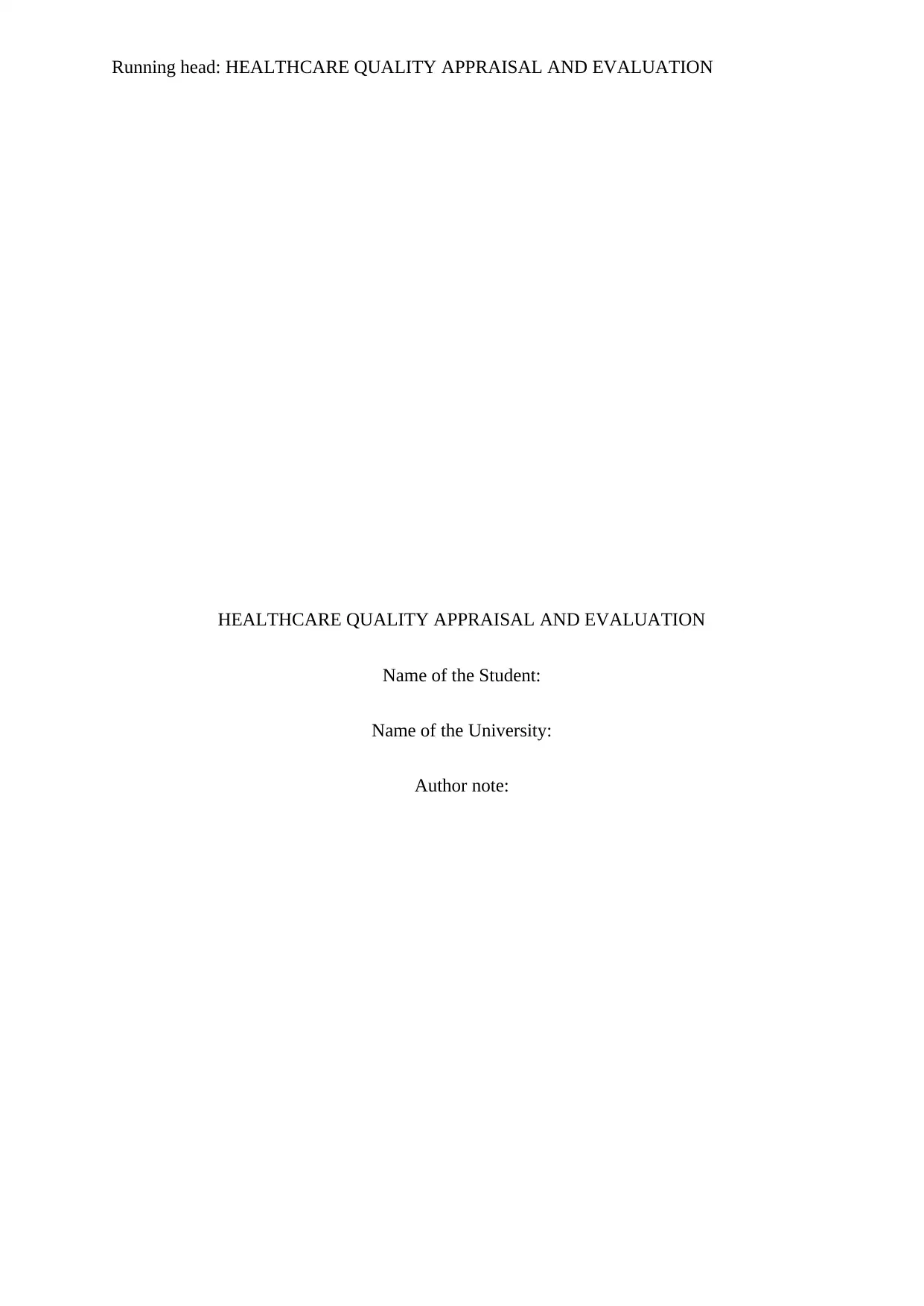
Running head: HEALTHCARE QUALITY APPRAISAL AND EVALUATION
HEALTHCARE QUALITY APPRAISAL AND EVALUATION
Name of the Student:
Name of the University:
Author note:
HEALTHCARE QUALITY APPRAISAL AND EVALUATION
Name of the Student:
Name of the University:
Author note:
Paraphrase This Document
Need a fresh take? Get an instant paraphrase of this document with our AI Paraphraser
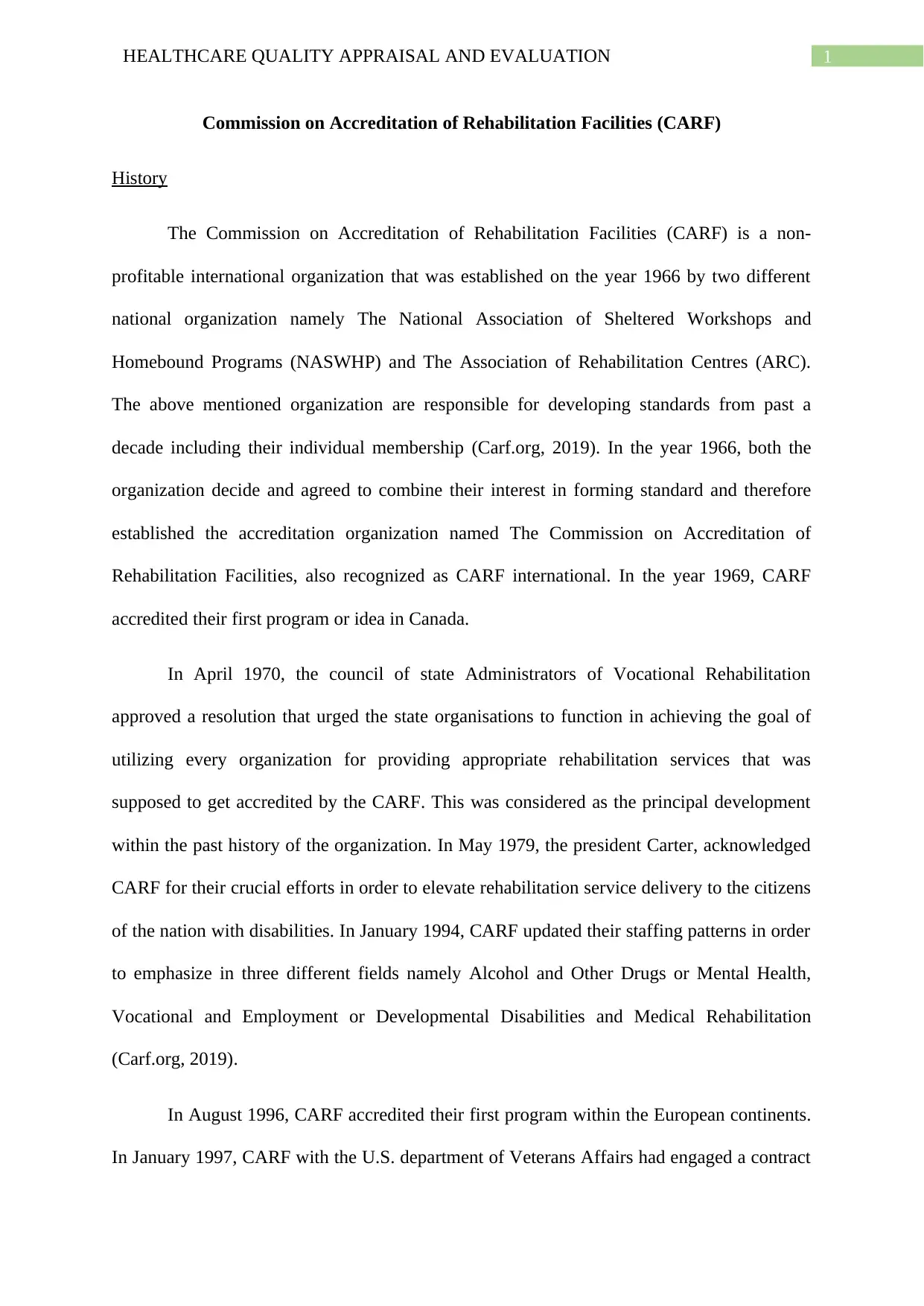
1HEALTHCARE QUALITY APPRAISAL AND EVALUATION
Commission on Accreditation of Rehabilitation Facilities (CARF)
History
The Commission on Accreditation of Rehabilitation Facilities (CARF) is a non-
profitable international organization that was established on the year 1966 by two different
national organization namely The National Association of Sheltered Workshops and
Homebound Programs (NASWHP) and The Association of Rehabilitation Centres (ARC).
The above mentioned organization are responsible for developing standards from past a
decade including their individual membership (Carf.org, 2019). In the year 1966, both the
organization decide and agreed to combine their interest in forming standard and therefore
established the accreditation organization named The Commission on Accreditation of
Rehabilitation Facilities, also recognized as CARF international. In the year 1969, CARF
accredited their first program or idea in Canada.
In April 1970, the council of state Administrators of Vocational Rehabilitation
approved a resolution that urged the state organisations to function in achieving the goal of
utilizing every organization for providing appropriate rehabilitation services that was
supposed to get accredited by the CARF. This was considered as the principal development
within the past history of the organization. In May 1979, the president Carter, acknowledged
CARF for their crucial efforts in order to elevate rehabilitation service delivery to the citizens
of the nation with disabilities. In January 1994, CARF updated their staffing patterns in order
to emphasize in three different fields namely Alcohol and Other Drugs or Mental Health,
Vocational and Employment or Developmental Disabilities and Medical Rehabilitation
(Carf.org, 2019).
In August 1996, CARF accredited their first program within the European continents.
In January 1997, CARF with the U.S. department of Veterans Affairs had engaged a contract
Commission on Accreditation of Rehabilitation Facilities (CARF)
History
The Commission on Accreditation of Rehabilitation Facilities (CARF) is a non-
profitable international organization that was established on the year 1966 by two different
national organization namely The National Association of Sheltered Workshops and
Homebound Programs (NASWHP) and The Association of Rehabilitation Centres (ARC).
The above mentioned organization are responsible for developing standards from past a
decade including their individual membership (Carf.org, 2019). In the year 1966, both the
organization decide and agreed to combine their interest in forming standard and therefore
established the accreditation organization named The Commission on Accreditation of
Rehabilitation Facilities, also recognized as CARF international. In the year 1969, CARF
accredited their first program or idea in Canada.
In April 1970, the council of state Administrators of Vocational Rehabilitation
approved a resolution that urged the state organisations to function in achieving the goal of
utilizing every organization for providing appropriate rehabilitation services that was
supposed to get accredited by the CARF. This was considered as the principal development
within the past history of the organization. In May 1979, the president Carter, acknowledged
CARF for their crucial efforts in order to elevate rehabilitation service delivery to the citizens
of the nation with disabilities. In January 1994, CARF updated their staffing patterns in order
to emphasize in three different fields namely Alcohol and Other Drugs or Mental Health,
Vocational and Employment or Developmental Disabilities and Medical Rehabilitation
(Carf.org, 2019).
In August 1996, CARF accredited their first program within the European continents.
In January 1997, CARF with the U.S. department of Veterans Affairs had engaged a contract
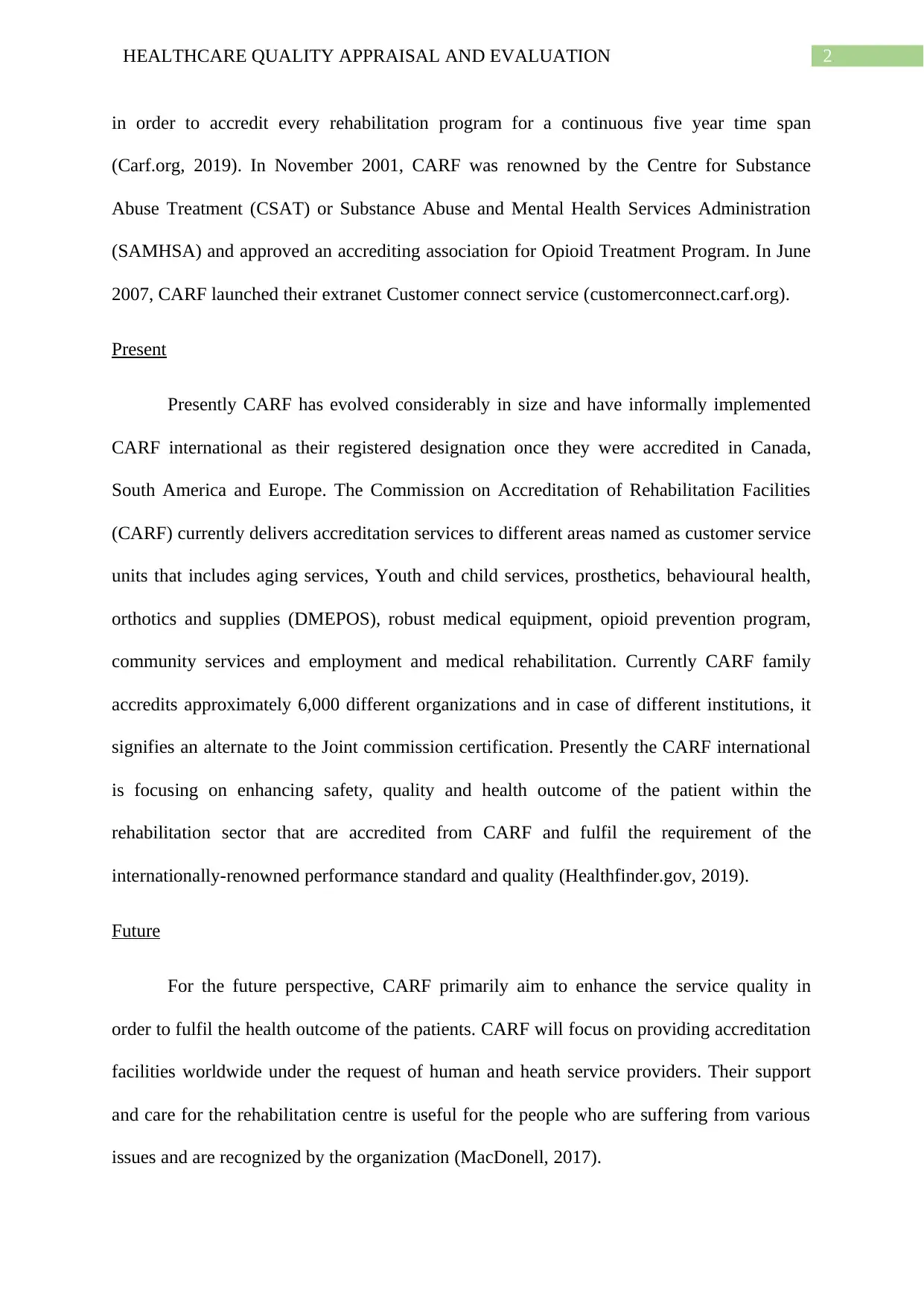
2HEALTHCARE QUALITY APPRAISAL AND EVALUATION
in order to accredit every rehabilitation program for a continuous five year time span
(Carf.org, 2019). In November 2001, CARF was renowned by the Centre for Substance
Abuse Treatment (CSAT) or Substance Abuse and Mental Health Services Administration
(SAMHSA) and approved an accrediting association for Opioid Treatment Program. In June
2007, CARF launched their extranet Customer connect service (customerconnect.carf.org).
Present
Presently CARF has evolved considerably in size and have informally implemented
CARF international as their registered designation once they were accredited in Canada,
South America and Europe. The Commission on Accreditation of Rehabilitation Facilities
(CARF) currently delivers accreditation services to different areas named as customer service
units that includes aging services, Youth and child services, prosthetics, behavioural health,
orthotics and supplies (DMEPOS), robust medical equipment, opioid prevention program,
community services and employment and medical rehabilitation. Currently CARF family
accredits approximately 6,000 different organizations and in case of different institutions, it
signifies an alternate to the Joint commission certification. Presently the CARF international
is focusing on enhancing safety, quality and health outcome of the patient within the
rehabilitation sector that are accredited from CARF and fulfil the requirement of the
internationally-renowned performance standard and quality (Healthfinder.gov, 2019).
Future
For the future perspective, CARF primarily aim to enhance the service quality in
order to fulfil the health outcome of the patients. CARF will focus on providing accreditation
facilities worldwide under the request of human and heath service providers. Their support
and care for the rehabilitation centre is useful for the people who are suffering from various
issues and are recognized by the organization (MacDonell, 2017).
in order to accredit every rehabilitation program for a continuous five year time span
(Carf.org, 2019). In November 2001, CARF was renowned by the Centre for Substance
Abuse Treatment (CSAT) or Substance Abuse and Mental Health Services Administration
(SAMHSA) and approved an accrediting association for Opioid Treatment Program. In June
2007, CARF launched their extranet Customer connect service (customerconnect.carf.org).
Present
Presently CARF has evolved considerably in size and have informally implemented
CARF international as their registered designation once they were accredited in Canada,
South America and Europe. The Commission on Accreditation of Rehabilitation Facilities
(CARF) currently delivers accreditation services to different areas named as customer service
units that includes aging services, Youth and child services, prosthetics, behavioural health,
orthotics and supplies (DMEPOS), robust medical equipment, opioid prevention program,
community services and employment and medical rehabilitation. Currently CARF family
accredits approximately 6,000 different organizations and in case of different institutions, it
signifies an alternate to the Joint commission certification. Presently the CARF international
is focusing on enhancing safety, quality and health outcome of the patient within the
rehabilitation sector that are accredited from CARF and fulfil the requirement of the
internationally-renowned performance standard and quality (Healthfinder.gov, 2019).
Future
For the future perspective, CARF primarily aim to enhance the service quality in
order to fulfil the health outcome of the patients. CARF will focus on providing accreditation
facilities worldwide under the request of human and heath service providers. Their support
and care for the rehabilitation centre is useful for the people who are suffering from various
issues and are recognized by the organization (MacDonell, 2017).
⊘ This is a preview!⊘
Do you want full access?
Subscribe today to unlock all pages.

Trusted by 1+ million students worldwide
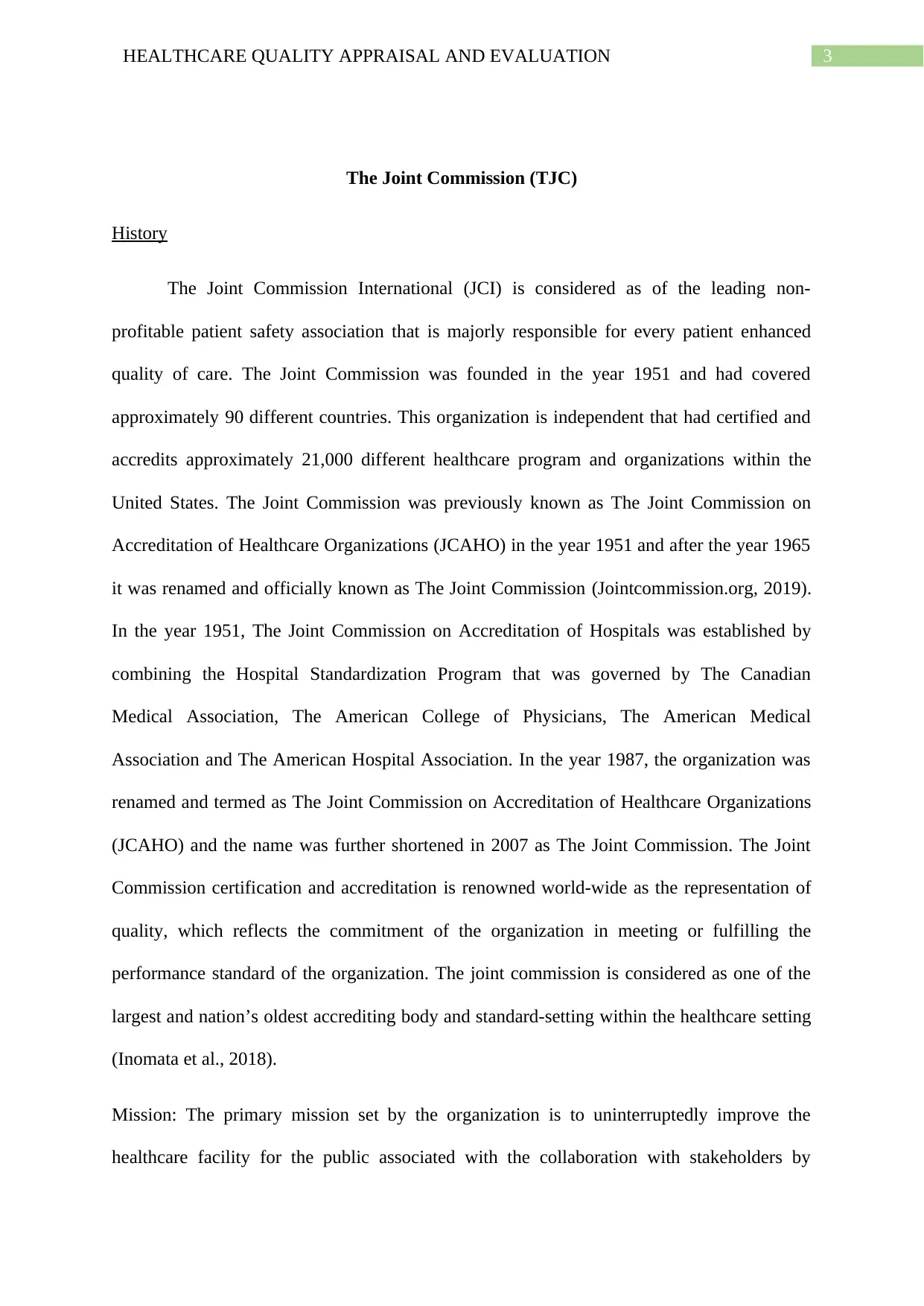
3HEALTHCARE QUALITY APPRAISAL AND EVALUATION
The Joint Commission (TJC)
History
The Joint Commission International (JCI) is considered as of the leading non-
profitable patient safety association that is majorly responsible for every patient enhanced
quality of care. The Joint Commission was founded in the year 1951 and had covered
approximately 90 different countries. This organization is independent that had certified and
accredits approximately 21,000 different healthcare program and organizations within the
United States. The Joint Commission was previously known as The Joint Commission on
Accreditation of Healthcare Organizations (JCAHO) in the year 1951 and after the year 1965
it was renamed and officially known as The Joint Commission (Jointcommission.org, 2019).
In the year 1951, The Joint Commission on Accreditation of Hospitals was established by
combining the Hospital Standardization Program that was governed by The Canadian
Medical Association, The American College of Physicians, The American Medical
Association and The American Hospital Association. In the year 1987, the organization was
renamed and termed as The Joint Commission on Accreditation of Healthcare Organizations
(JCAHO) and the name was further shortened in 2007 as The Joint Commission. The Joint
Commission certification and accreditation is renowned world-wide as the representation of
quality, which reflects the commitment of the organization in meeting or fulfilling the
performance standard of the organization. The joint commission is considered as one of the
largest and nation’s oldest accrediting body and standard-setting within the healthcare setting
(Inomata et al., 2018).
Mission: The primary mission set by the organization is to uninterruptedly improve the
healthcare facility for the public associated with the collaboration with stakeholders by
The Joint Commission (TJC)
History
The Joint Commission International (JCI) is considered as of the leading non-
profitable patient safety association that is majorly responsible for every patient enhanced
quality of care. The Joint Commission was founded in the year 1951 and had covered
approximately 90 different countries. This organization is independent that had certified and
accredits approximately 21,000 different healthcare program and organizations within the
United States. The Joint Commission was previously known as The Joint Commission on
Accreditation of Healthcare Organizations (JCAHO) in the year 1951 and after the year 1965
it was renamed and officially known as The Joint Commission (Jointcommission.org, 2019).
In the year 1951, The Joint Commission on Accreditation of Hospitals was established by
combining the Hospital Standardization Program that was governed by The Canadian
Medical Association, The American College of Physicians, The American Medical
Association and The American Hospital Association. In the year 1987, the organization was
renamed and termed as The Joint Commission on Accreditation of Healthcare Organizations
(JCAHO) and the name was further shortened in 2007 as The Joint Commission. The Joint
Commission certification and accreditation is renowned world-wide as the representation of
quality, which reflects the commitment of the organization in meeting or fulfilling the
performance standard of the organization. The joint commission is considered as one of the
largest and nation’s oldest accrediting body and standard-setting within the healthcare setting
(Inomata et al., 2018).
Mission: The primary mission set by the organization is to uninterruptedly improve the
healthcare facility for the public associated with the collaboration with stakeholders by
Paraphrase This Document
Need a fresh take? Get an instant paraphrase of this document with our AI Paraphraser
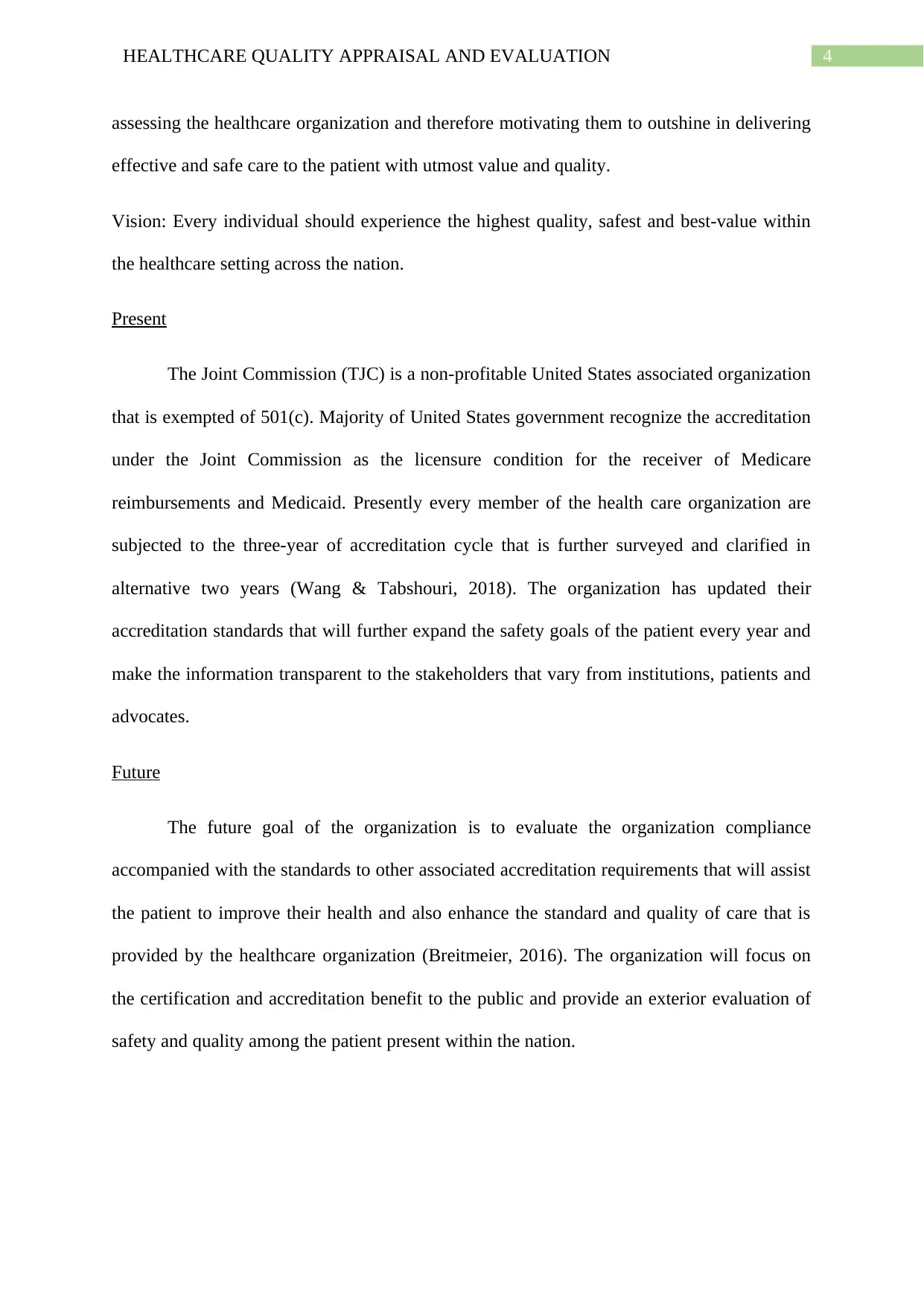
4HEALTHCARE QUALITY APPRAISAL AND EVALUATION
assessing the healthcare organization and therefore motivating them to outshine in delivering
effective and safe care to the patient with utmost value and quality.
Vision: Every individual should experience the highest quality, safest and best-value within
the healthcare setting across the nation.
Present
The Joint Commission (TJC) is a non-profitable United States associated organization
that is exempted of 501(c). Majority of United States government recognize the accreditation
under the Joint Commission as the licensure condition for the receiver of Medicare
reimbursements and Medicaid. Presently every member of the health care organization are
subjected to the three-year of accreditation cycle that is further surveyed and clarified in
alternative two years (Wang & Tabshouri, 2018). The organization has updated their
accreditation standards that will further expand the safety goals of the patient every year and
make the information transparent to the stakeholders that vary from institutions, patients and
advocates.
Future
The future goal of the organization is to evaluate the organization compliance
accompanied with the standards to other associated accreditation requirements that will assist
the patient to improve their health and also enhance the standard and quality of care that is
provided by the healthcare organization (Breitmeier, 2016). The organization will focus on
the certification and accreditation benefit to the public and provide an exterior evaluation of
safety and quality among the patient present within the nation.
assessing the healthcare organization and therefore motivating them to outshine in delivering
effective and safe care to the patient with utmost value and quality.
Vision: Every individual should experience the highest quality, safest and best-value within
the healthcare setting across the nation.
Present
The Joint Commission (TJC) is a non-profitable United States associated organization
that is exempted of 501(c). Majority of United States government recognize the accreditation
under the Joint Commission as the licensure condition for the receiver of Medicare
reimbursements and Medicaid. Presently every member of the health care organization are
subjected to the three-year of accreditation cycle that is further surveyed and clarified in
alternative two years (Wang & Tabshouri, 2018). The organization has updated their
accreditation standards that will further expand the safety goals of the patient every year and
make the information transparent to the stakeholders that vary from institutions, patients and
advocates.
Future
The future goal of the organization is to evaluate the organization compliance
accompanied with the standards to other associated accreditation requirements that will assist
the patient to improve their health and also enhance the standard and quality of care that is
provided by the healthcare organization (Breitmeier, 2016). The organization will focus on
the certification and accreditation benefit to the public and provide an exterior evaluation of
safety and quality among the patient present within the nation.
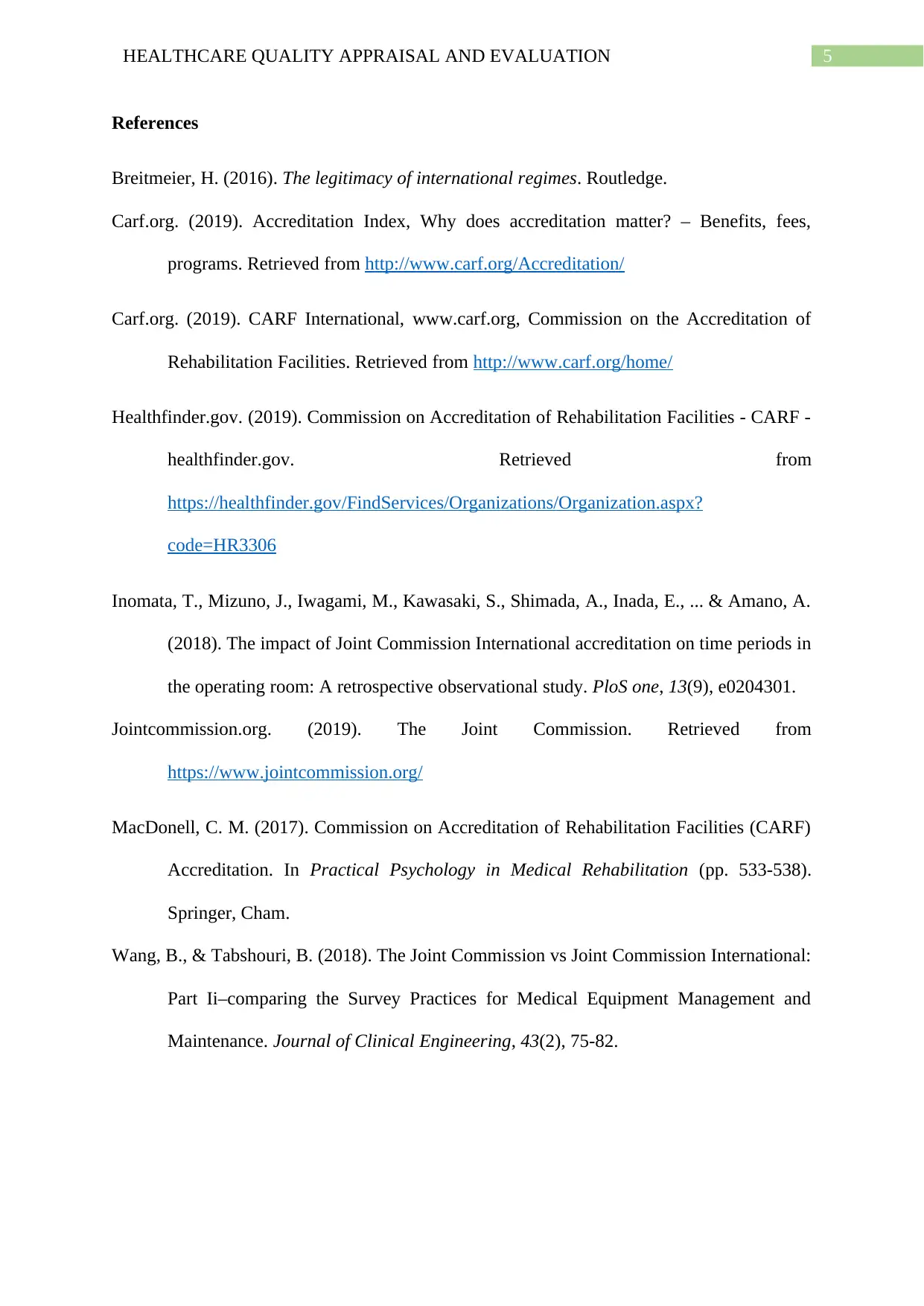
5HEALTHCARE QUALITY APPRAISAL AND EVALUATION
References
Breitmeier, H. (2016). The legitimacy of international regimes. Routledge.
Carf.org. (2019). Accreditation Index, Why does accreditation matter? – Benefits, fees,
programs. Retrieved from http://www.carf.org/Accreditation/
Carf.org. (2019). CARF International, www.carf.org, Commission on the Accreditation of
Rehabilitation Facilities. Retrieved from http://www.carf.org/home/
Healthfinder.gov. (2019). Commission on Accreditation of Rehabilitation Facilities - CARF -
healthfinder.gov. Retrieved from
https://healthfinder.gov/FindServices/Organizations/Organization.aspx?
code=HR3306
Inomata, T., Mizuno, J., Iwagami, M., Kawasaki, S., Shimada, A., Inada, E., ... & Amano, A.
(2018). The impact of Joint Commission International accreditation on time periods in
the operating room: A retrospective observational study. PloS one, 13(9), e0204301.
Jointcommission.org. (2019). The Joint Commission. Retrieved from
https://www.jointcommission.org/
MacDonell, C. M. (2017). Commission on Accreditation of Rehabilitation Facilities (CARF)
Accreditation. In Practical Psychology in Medical Rehabilitation (pp. 533-538).
Springer, Cham.
Wang, B., & Tabshouri, B. (2018). The Joint Commission vs Joint Commission International:
Part Ii–comparing the Survey Practices for Medical Equipment Management and
Maintenance. Journal of Clinical Engineering, 43(2), 75-82.
References
Breitmeier, H. (2016). The legitimacy of international regimes. Routledge.
Carf.org. (2019). Accreditation Index, Why does accreditation matter? – Benefits, fees,
programs. Retrieved from http://www.carf.org/Accreditation/
Carf.org. (2019). CARF International, www.carf.org, Commission on the Accreditation of
Rehabilitation Facilities. Retrieved from http://www.carf.org/home/
Healthfinder.gov. (2019). Commission on Accreditation of Rehabilitation Facilities - CARF -
healthfinder.gov. Retrieved from
https://healthfinder.gov/FindServices/Organizations/Organization.aspx?
code=HR3306
Inomata, T., Mizuno, J., Iwagami, M., Kawasaki, S., Shimada, A., Inada, E., ... & Amano, A.
(2018). The impact of Joint Commission International accreditation on time periods in
the operating room: A retrospective observational study. PloS one, 13(9), e0204301.
Jointcommission.org. (2019). The Joint Commission. Retrieved from
https://www.jointcommission.org/
MacDonell, C. M. (2017). Commission on Accreditation of Rehabilitation Facilities (CARF)
Accreditation. In Practical Psychology in Medical Rehabilitation (pp. 533-538).
Springer, Cham.
Wang, B., & Tabshouri, B. (2018). The Joint Commission vs Joint Commission International:
Part Ii–comparing the Survey Practices for Medical Equipment Management and
Maintenance. Journal of Clinical Engineering, 43(2), 75-82.
⊘ This is a preview!⊘
Do you want full access?
Subscribe today to unlock all pages.

Trusted by 1+ million students worldwide
1 out of 6
Related Documents
Your All-in-One AI-Powered Toolkit for Academic Success.
+13062052269
info@desklib.com
Available 24*7 on WhatsApp / Email
![[object Object]](/_next/static/media/star-bottom.7253800d.svg)
Unlock your academic potential
Copyright © 2020–2025 A2Z Services. All Rights Reserved. Developed and managed by ZUCOL.





